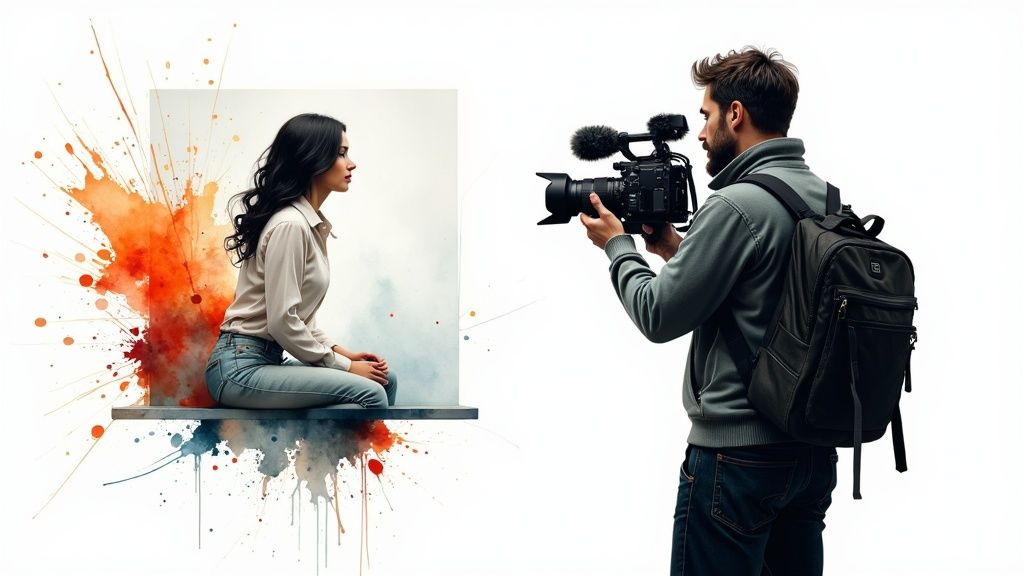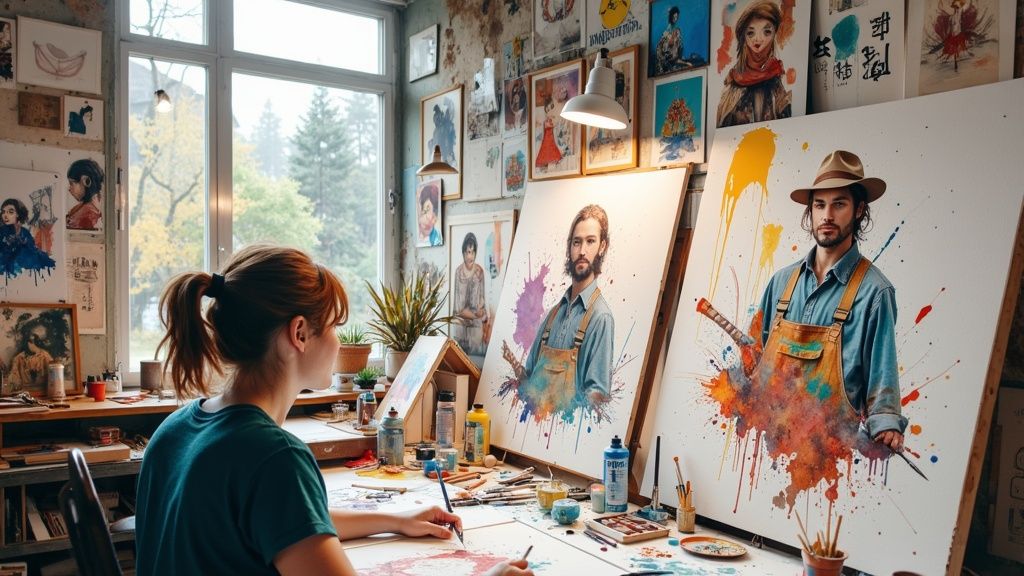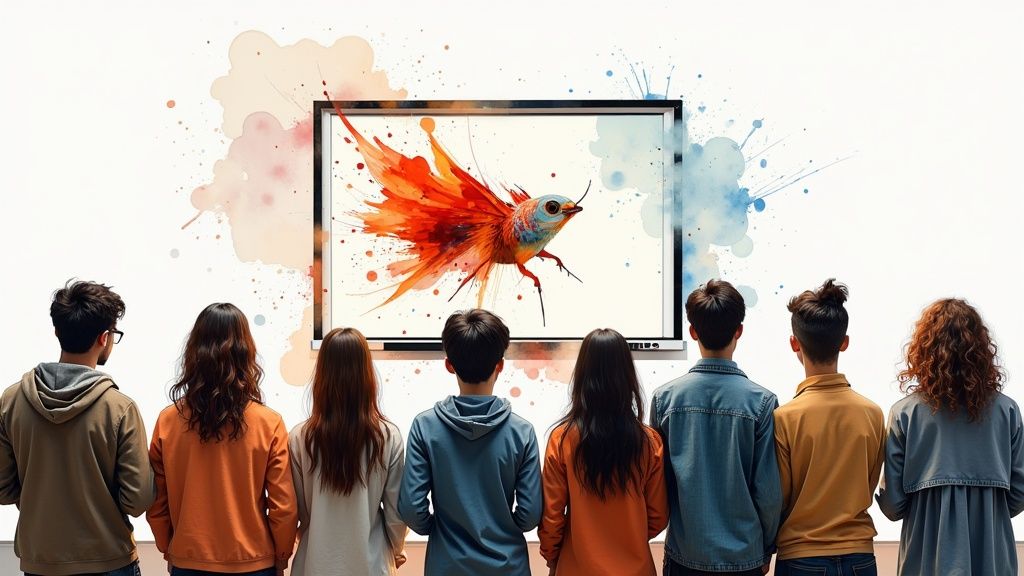Understanding the Rise of AI Video Creation
AI is fundamentally changing how we create videos. Gone are the days when professional video production required expensive equipment and years of technical expertise. Thanks to AI tools, anyone with a creative vision can now produce high-quality videos. This opens up exciting possibilities for content creators, small businesses, and individuals who previously found video production out of reach.
The Core Benefits of AI in Video Production
AI tools have brought major improvements to every stage of video creation. They can help with script generation, create natural-sounding voiceovers, develop animated characters, and handle complex editing tasks. AI can also match music to scenes and optimize videos for different social platforms. These capabilities mean creators can produce more content in less time while maintaining high quality.
The technology also helps creators make smarter content decisions. AI can analyze viewer data to understand what resonates with specific audiences. For example, you can use AI insights to adjust your video style, length, and topics based on how different viewer segments respond. This data-driven approach helps create videos that truly connect with target audiences.
Market Growth Shows Rising Demand
The numbers show just how quickly AI video creation is growing. The global AI video generator market reached USD 534.4 million in 2024 and is expected to hit USD 2,562.9 million by 2032. That's an impressive 19.5% annual growth rate. For more details, check out these AI video market statistics. These figures reflect how businesses and creators increasingly see AI video tools as essential for modern content creation.
The Human Element Remains Key
While AI brings powerful capabilities, human creativity is still at the heart of great video content. The most effective approach combines AI's technical abilities with human storytelling skills and artistic vision. Think of AI as your production assistant - it handles time-consuming technical tasks so you can focus on crafting compelling narratives and emotional connections. This partnership between human creativity and AI technology is what produces truly engaging videos that resonate with viewers.
Choosing the Right AI Video Creation Tools

With so many AI video tools now available, picking the right one for your needs is key. Each platform offers different capabilities, so understanding what matters most for your video projects will help you make a smart choice.
Key Features to Consider
When evaluating AI video tools, focus on the core features that match your goals. If you mainly turn blog posts into videos, you'll want strong text analysis and image matching. For animation projects, look for tools specializing in AI motion graphics.
Here are the main features to evaluate:
- Text-to-Video: Convert written content into engaging videos quickly and easily
- AI Script Creation: Get help writing compelling scripts from basic outlines
- Audio Tools: Built-in voiceover features and music libraries for professional sound
- Animation Options: Create eye-catching motion graphics and visual effects
- Smart Editing: AI-powered tools for smoother transitions and video enhancement
Testing Real Performance
Don't just look at feature lists - try the tools hands-on to see how they actually work. Test how accurately they convert your content and study examples from other creators using the platform. Real-world results matter more than marketing claims.
Building Your Toolkit
Many successful creators use multiple AI tools together. You might use one for scripts, another for animation, and a third for editing. This lets you pick the best tool for each part of your process rather than settling for an all-in-one solution that's mediocre at everything.
Budget and Value
Pricing varies widely, from free tiers to enterprise plans costing thousands. Consider both your budget and potential return on investment. Look at how much time and effort each tool could save you. The content creation segment makes up over 35% of the AI video market, showing strong demand for tools that speed up production. Learn more about industry trends in AI video.
Advanced Features and Future Growth
Look beyond basic features to find helpful extras that could improve your workflow. Some tools offer custom options or connect with other software you use. Also consider each platform's development plans and how they add new AI capabilities. Choose tools that keep improving so your investment stays valuable as AI technology advances.
Building an AI-Powered Video Production Workflow
Creating engaging videos with AI requires thoughtful integration of tools into your production process. By studying how successful creators blend AI capabilities with their creative skills, you can significantly boost your video output quality and speed.
Automating Repetitive Tasks
AI excels at handling the time-consuming parts of video production that don't require creative judgment. Tasks like generating subtitles, creating lower thirds, and finding b-roll footage can be automated, giving you more time to focus on storytelling and creative direction. For instance, AI tools can transcribe audio with 98% accuracy, saving hours of manual work.
Maintaining Creative Control
While AI brings powerful automation, you remain in charge of the creative vision. Think of AI as your assistant rather than the director. You might use AI to create an initial script draft, but then revise it to match your unique voice and style. The same goes for AI-suggested music and visuals - you make the final artistic choices.
From Concept to Delivery: Integrating AI at Every Stage
AI tools can enhance each phase of video production. During planning, AI assists with ideas and storyboarding. In production, it helps with editing and transitions. For post-production, AI improves audio and creates custom voiceovers. Companies report up to 80% time savings when using AI in their video workflow compared to traditional methods. Check out more data on AI video production here.
Consistency Across Large-Scale Projects
For teams creating multiple videos, maintaining a consistent look and feel is crucial. AI tools excel at applying uniform branding elements, color schemes, and audio styles across entire video series. Want to learn more? Read about How AI is Transforming Video Quality. By setting up AI templates and style guides, you ensure every video aligns perfectly with your brand while saving significant production time.
Creating High-Converting Video Marketing Campaigns

Creating effective marketing campaigns for AI-generated videos requires both creative content and smart distribution strategies. The key is delivering videos that connect with your target viewers and drive real business results. Let's explore how to turn AI video content into marketing success stories.
Understanding Your Target Audience
Before creating any video content, you need to know who you're making it for. Research your audience's demographics, preferred platforms, and content engagement patterns. For example, younger viewers on TikTok tend to prefer snappy 30-second clips, while LinkedIn users often engage more with detailed, educational content. These insights help ensure your videos hit the mark.
Crafting Compelling Narratives
While AI tools make video creation easier, strong storytelling remains essential. Focus on building a clear narrative structure with an engaging hook, meaningful content, and satisfying conclusion. Consider what message or feeling you want viewers to walk away with. The best AI-generated videos combine technical capabilities with authentic human storytelling.
Combining AI Tools With Marketing Best Practices
AI streamlines video production, but core marketing principles still matter. Every video needs clear calls-to-action, consistent brand messaging, and strategic promotion across relevant channels. According to recent data, 44% of marketers now use AI in their video creation process - from scriptwriting to voiceovers. See the full research here. This shows how AI is becoming a standard part of video marketing.
Testing and Optimizing Your Video Content
Creating the video is just the beginning. Track key metrics like watch time, engagement rates, and conversion data to understand what resonates with your audience. Use these insights to improve future videos. For instance, if viewers consistently drop off at certain timestamps, adjust the pacing or content structure in those sections.
Scaling What Works: Repurposing and Adapting Content
Once you find formats that perform well, expand their reach through smart repurposing. Turn longer videos into social media clips, or adapt webinar content into bite-sized tutorial series. Learn more about effective content adaptation in this guide: How to Create Video Content for Social Media. This approach helps you get more value from your video assets while maintaining quality and consistency.
Preparing for the Next Wave of AI Video Innovation

The world of AI video creation keeps moving forward at a rapid pace. To stay competitive, creators need to understand new developments and adapt their methods to make the most of emerging capabilities. Let's explore the key trends shaping the future of AI video production.
Advanced Personalization and Targeting with AI
AI-powered personalization is becoming more refined and effective. Content creators can now design videos that automatically adjust their content based on who's watching - from customized messaging to visuals and music that match viewer preferences. When done right, this personalized approach helps boost engagement and drives better results.
The Rise of New Rendering Technologies
AI rendering tools are changing how we create videos. These new systems process footage faster while delivering better quality. They let creators generate complex effects and animations quickly, which means more time for the creative work that matters.
Sustainable Production Practices in the Age of AI
As AI video tools get more powerful, we need to focus on sustainable and ethical practices. This means finding ways to use resources efficiently and being mindful of important issues like copyright and preventing misuse through deepfakes. Good practices now will help build trust in AI-created content.
Evaluating and Integrating New Tools and Techniques
With AI video tools evolving quickly, creators need clear ways to assess what's worth adopting. This means testing new features, seeing how they fit existing workflows, and measuring their real impact. According to industry research, the AI video generation market will reach USD 1.92 billion by 2029 - learn more about market growth here. These numbers show why staying current with new tools matters.
Positioning Yourself for Success
Smart creators are getting ready for what's next in AI video. They test new tools, improve their processes, and build connections with others using similar technology. Taking an open, experimental approach helps creators not just keep up but also help shape how AI transforms video production. The key is learning to use AI effectively while staying true to creative and ethical principles.
Maximizing Impact Across Digital Platforms

Making great AI videos is just the first step. To get real results, you need to adapt your content for each platform where your target viewers spend time. This means knowing what works best on different platforms and adjusting your approach to match.
Platform-Specific Optimization Strategies
Each social platform has its own unique audience and algorithm preferences. What goes viral on TikTok may fall flat on LinkedIn. Here are key factors to consider when optimizing your AI videos:
- Video Length: Keep it short (under 60 seconds) for TikTok and Instagram Reels. Save longer, detailed content for YouTube or educational sites.
- Screen Format: Use vertical (9:16) for mobile-first platforms, horizontal (16:9) for YouTube/desktop, and square (1:1) for Instagram feeds. Pick AI video tools that can easily switch between formats.
- Captions: Add text captions to reach viewers watching without sound and improve accessibility. Most platforms give better visibility to videos with captions.
- Search Terms: Research popular hashtags and keywords for each platform. Mix broad terms with specific niche ones to help people find your content.
- Audio: Use upbeat, trending sounds for TikTok. Keep it professional with clear voiceovers and subtle background music for business content.
Smart Content Reuse
Don't start from scratch for every platform. Break down your AI videos strategically - turn a long YouTube video into quick clips for Instagram and TikTok to reach more viewers efficiently.
Learning From Top Performers
Study successful videos in your niche. What made them work? Was it the pacing, visuals, story structure, or several elements combined? Check out our guide on How to master social media video for more tips. Apply these insights to improve your own AI video content.
Smooth Multi-Platform Publishing
Managing videos across platforms takes work. Use AI tools that automate tasks like resizing, captioning, and scheduling posts. This frees up time to focus on creative strategy and connecting with your audience instead of technical details.
Track and Improve
Monitor key stats like views, watch time, shares, and comments for your AI videos. This data shows what resonates with viewers. Use these insights to keep improving your content approach. Regular analysis helps ensure your videos perform well across all your chosen platforms.
Ready to upgrade your video creation? Meet Aeon, a smart video platform that helps publishers easily create engaging videos from text, video, or audio files. Aeon uses AI to handle voice customization, text-to-video conversion, and social media formatting, so you can make quality videos faster. Visit Aeon to learn more about making your video workflow more efficient.